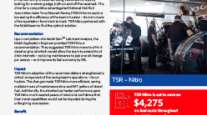Diesel Increases 7.3¢ to $2.09; 1st Price Rise in Over 2 Months
This story appears in the March 30 print edition of Transport Topics.
Rising oil prices and growing distillate demand pushed the U.S. national diesel average 7.3 cents higher to $2.09 last week, the first increase in more than two months, the Department of Energy reported.
The increase in the price of commercial trucking’s main fuel was the steepest since an 8.2-cent spike in July and the first since Jan. 12.
For a truck getting 6 miles per gallon, the spike last week slapped a $12 premium on every 1,000-mile trip. The run would consume almost $350 worth of diesel, based on DOE’s March 23 survey of fueling stations.
“Crude’s the dog, [diesel is] the tail,” said Bruce Gress, director of petroleum risk management for Pilot Travel Centers, Knoxville, Tenn. “Crude has been rallying on what people are perceiving as more positive economic news.”
Crude on March 23 closed at $54 a barrel on the New York Mercantile Exchange, the highest since late November.
Mary Novak, a petroleum analyst with HIS Global Insight, concurred with Gress.
“You’re seeing pass-through” from more expensive crude oil, said Novak. She said robust stockpiles of distillates, which have accumulated during the recession, “kept the price increase from happening until now,” even though crude has been on the rise for the past two months.
Despite the diesel increase, the national average is about 48% lower than in the corresponding week in 2008. Diesel is also down $2.674 from its record last July.
DOE also reported the national average price of gasoline rose 5.2 cents to $1.96 a gallon. With the exception of a 3.1-cent drop on March 16, gas has risen every week this month. Gasoline has now climbed 34.9 cents from its 12-month low, recorded in the final week of December.
The gasoline average is about 40% below year-ago levels and has fallen $2.152 from its own July record, according to DOE.
The trucking industry burns about 752 million gallons of diesel and about 284.6 million gallons of gas every week, according to American Trucking Associations.
The spike in the diesel average came as no surprise to the president of one regional truckload carrier, who said his company is maintaining all fuel-saving initiatives it instituted during last summer’s fuel crisis.
Last May, “we lowered the speed of our vehicles 5 miles per hour,” said Carl Bumgarner, president of Fleetmaster Express in Roanoke, Va.
The speed reduction allowed the carrier to “travel 30,000 more miles on 13,000 fewer gallons fuel,” saving about $97,000 a month, Bumgarner estimated.
As the economy turned south last year, Fleetmaster was able to squeeze savings out of major truck-stop chains, which, Bumgarner said, are now more likely to negotiate fuel discounts because “they need the gallons. They’re looking for business, just like everybody else.”
In the first quarter of 2008, Fleetmaster was getting about $10,000 a month in discounts from its fuel vendors. This February, the monthly discount widened to about $54,000.
Fleetmaster operates primarily in the mid-Atlantic, Mid-west and Southeast regions. The carrier burned an average of 327,000 gallons of diesel a month in the first two months of the year.
Also last week, DOE said distillate demand for the week ended March 20 was about 3.9 million barrels a day, an increase of about 300,000 barrels a day since the end of February. In the same period, the amount of distillate fuel produced by U.S. refiners fell by about 375,000 barrels.
“The diesel consumers had been insulated from the rising oil prices . . . because of weak demand and high inventories,” DOE’s Tancred Lidderdale told Transport Topics. “But that insulation has been worn out.”
Both Gress and Novak also said high inventory levels here had prompted an uptick in exports to Europe, further driving up domestic prices.
On March 25, DOE’s weekly inventory report revealed that oil stockpiles for the week ended March 20 rose to 356.6 million barrels, the highest level since 1993.
The oil surplus means that the OPEC oil cartel might idle more production to buoy oil prices, taking refined fuels along for the ride, Novak said.
OPEC on Jan. 1 cut production by 4.2 million barrels a day to about 24.85 million barrels a day. In its latest meeting earlier this month, the cartel elected to hold production steady.




